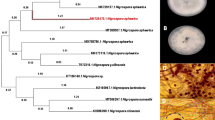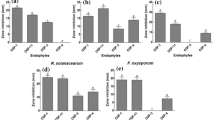Abstract
Endophytic microorganisms produce a range of bioactive metabolites and support plant growth and their competitiveness. The present study aims to characterize an endophytic, antagonistic and pigment producing bacterium (GBPI_TWL), isolated from the roots of Taxus wallichiana Zucc. Following morphological, biochemical, and molecular characters, the bacterium was identified as Burkholderia sp. The bacterium produced diffusible and volatile antimicrobials against phytopathogens Alternaria alternata, Fusarium oxysporum, and F. Solani in plate bioassays. Effect of physicochemical parameters like temperature, pH, carbon and nitrogen source were also tested for higher yield of pigment. Bacterial pigment production was found higher at 25 °C and pH 6. Besides, maltose and ammonium chloride as carbon and nitrogen source, respectively, enhanced the pigment production. After optimization of pigment production, the bacterial pigment was extracted in four different solvents (sequentially) viz. benzene, ethyl acetate, ethanol and methanol. These crude organic extracts, were tested for antimicrobial activity against three groups of microorganisms (bacteria, actinobacteria and fungi). Silica gel column chromatography was used for the purification of active compounds having antimicrobial activity. Separation was monitored by UV-VIS spectroscopy. After successive fractionation, finally two fractions MEF1 (a) and EAEF2 (a) were selected for structural identification of antimicrobial compounds by using gas chromatography- mass spectrometry. Mass spectra results revealed the presence of secondary metabolites of antimicrobial nature including fatty acids (hexadecanoic acid, eicosanoic acid octadecenoic acid, docosanoic acid), aromatic dicarboxylic acids (benzenedicarboxylic acid, phthalic acid), saturated hydrocarbon (Heneicosane, Nonacosan-14-one), and cycloalkyes (cyclododecyne).



Similar content being viewed by others
Abbreviations
- TYE Agar :
-
Tryptone Yeast extract Agar
- PDA :
-
Potato Dextrose Agar
- TYE broth :
-
Tryptone Yeast Extract broth
- GC-MS :
-
gas chromatography-mass spectrometry
- NCBI :
-
National Center for Biotechnology Information
- MIC :
-
Minimum inhibitory concentration
- NRRL :
-
Northern Regional Research Laboratory
- MCC :
-
Microbial Culture Collection
- NCCS :
-
National Centre for Cell Science
- ITCC :
-
Indian Type Culture Collection
- IARI :
-
Indian Agricultural Research Institute
References
Adhikari P, Pandey A (2019) Phosphate solubilization potential of endophytic fungi isolated from Taxus wallichiana Zucc. Roots. Rhizosphere 9:2–9. https://doi.org/10.1016/j.rhisph.2018.11.002
Adhikari P, Pandey A (2020) Bioprospecting plant growth promoting endophytic bacteria isolated from Himalayan yew (Taxus wallichiana Zucc.). Microbiol Res 239:126536. https://doi.org/10.1016/j.micres.2020.126536
Adhikari P, Pandey A, Agnihotri V et al (2018) Selection of solvent and extraction method for determination of antimicrobial potential of Taxus wallichiana Zucc. Res Pharm 8:1–9. https://doi.org/10.25081/rip.2018.v8.3487
Ashitha A, Radhakrishnan EK, Mathew J (2020) Antibacterial potential and apoptosis induction by pigments from the endophyte Burkholderia sp. WYAT7. Curr Microbiol 77:2475–2485. https://doi.org/10.1007/s00284-020-02013-3
Banerjee D, Chatterjee S, Banerjee UC et al (2011) Green pigment from Bacillus cereus M116 (MTCC 5521): production parameters and antibacterial activity. Appl Biochem Biotechnol 164:67–779. https://doi.org/10.1007/s12010-011-9172-8
Brader G, Compant S, Mitter B et al (2014) Metabolic potential of endophytic bacteria. Curr Opin Biotechnol 27:30–37. https://doi.org/10.1016/j.copbio.2013.09.012
Clinical and Laboratory Standard Institute (CLSI 2008) Reference method for broth dilution antifungal susceptibility testing of yeast, Approved standard- Third edition. CLSI document M27-A3. Wayne. 2008
Dhakar K, Pandey A (2016) Wide pH range tolerance in extremophiles: towards understanding an important phenomenon for future biotechnology. Appl Microbiol Biotechnol 100:2499–2510. https://doi.org/10.1007/s00253-016-7285-2
Gondil VS, Asif M, Bhalla TK (2017) Optimization of physicochemical parameters influencing the production of prodigiosin from Serratia nematodiphila RL2 and exploring its antibacterial activity. 3 biotech 7 (338): 1–8. https://doi.org/10.1007/s13205-017-0979-z
Igwe KK, Okafor PN, Ijeh II (2015)GC-MS analysis of phytocomponents in Vernonia amygdalina. Del leaves and its contractile potential in mammary tissue in female albino Wistar rats. IOSR J Agric Vet Sci 8(11):25–30. https://doi.org/10.9790/2380-081112530
Jain R, Pandey A (2016) A phenazine-1-carboxylic acid producing polyextremophilic pseudomonas chlororaphis(MCC2693) strain, isolated from mountain ecosystem, possesses biocontrol and plant growth promotion abilities. Microbiol Res 190:63–71. https://doi.org/10.1016/j.micres.2016.04.017
Juyal D, Thawani V, Thaledi S et al (2014) Ethnomedical properties of Taxus wallichiana Zucc. (Himalayan yew). J Trad Complem Med 4(3):159–161. https://doi.org/10.4103/2225-4110.136544
Kumar S, Nei M, Dudley J et al (2008) MEGA: a biologist-centric software for evolutionary analysis of DNA and protein sequences. Brief Bioinform 9:299–306. https://doi.org/10.1093/bib/bbn017
Kumaresan N, Sanjay KR, Venkatesh KS et al (2008) Partially saturated canthaxanthin purified from aspergillus carbonarius induces apoptosis in prostate cancer cell line. Appl Microbiol Biotechnol 80:467–473. https://doi.org/10.1007/s00253-008-1538-7
Lloyd WJ, Broadhurst AV, Hall MJ et al (1988) Cyclohexane triones, novel membrane active antibacterial agents. Antimicrob Agents Chemothe 32(6):814–818. https://doi.org/10.15414/jmbfs.2019.9.1.84-87
Musa NN, Yusof NZ (2019) Chemical and physical parameters affecting bacterial pigment production. Mater Today: Proc 19:1608–1617. https://doi.org/10.1016/j.matpr.2019.11.189
Pandey A, Yarzabal LA (2018) Bioprospecting cold-adapted plant growth promoting microorganisms from mountain environments. Appl Microbiol Biotechnol 103(2):643–657. https://doi.org/10.1007/s00253-018-9515-2
Pandey N, Jain R, Pandey A et al (2018) Optimisation and characterisation of the orange pigment produced by a cold adapted strain of Penicillium sp. (GBPI_P155) isolated from mountain ecosystem. Mycology 9(2):81–92. https://doi.org/10.1080/21501203.2017.1423127
Patrovsky M, Sinovska K, Branska B et al (2019) Effect of initial pH, different nitrogen sources, and cultivation time on the production of yellow or orange Monascus purpureus pigments and the mycotoxin citrinin. Food Sci Nutr 7(11):3494–3500. https://doi.org/10.1002/fsn3.1197
Phatake YB, Dharmadhikari SM (2016) Physical parameters optimization for enhancement of prodigiosin production by using Serratia spp. World J Pharm Med Res 2(6):40–48
Rao MPN, Xiao M, Li WJ (2017) Fungal and bacterial pigments: secondary metabolites with wide applications. Front Microbiol 8:1113. https://doi.org/10.3389/fmicb.2017.01113
Rodriguez RJ, Freeman DC, McArthur ED et al (2009) Symbiotic regulation of plant growth, development and reproduction. Commun Integr Biol 2(2):141–143. https://doi.org/10.4161/cib.7821
Santoyo G, Hagelsieb GM, Orozco-Mosqueda MC et al (2016) Plant growth-promoting bacterial endophytes. Microbiol Res 183:92–99. https://doi.org/10.1016/j.micres.2015.11.008
Snyder LR (1978) Classification of the solvent properties of common liquids. J Chromatogra Sci 16:223–234. https://doi.org/10.1093/chromsci/16.6.223
Stange S, Steudler S, Delenk H et al (2019) Influence of the nutrients on the biomass and pigment production of Chlorociboria aeruginascens. J Fungi 5(40):1–15. https://doi.org/10.3390/jof5020040
Stierle A, Strobel G, Stierle D (1993) Taxol and taxane production by Taxomyces andreanae, an endophytic fungus of Pacific yew. Science 260(5105):214–216. https://doi.org/10.1126/science.8097061
Strobel GA (2003) Endophytes as sources of bioactive products. Microbes Infect 5:535–544. https://doi.org/10.1016/S1286-4579(03)00073-X
Sundaramoorthy N, Yogesh P, Dhandapani R (2009) Production of prodigiosin from Serratia marcescens isolated from soil. Ind J Sci Tech 2:32–34. https://doi.org/10.17485/ijst/2009/v2i10.5
Tayung K, Jha DK, Deka DC (2007) Isolation and identification of antimicrobial agent-producing bacterium from Taxus baccata rhizosphere antagonistic against clinically significant microbes. Ind J Microbiol 47:317–322. https://doi.org/10.1007/s12088-007-0058-y
Trivedi P, Pandey A, Palni LMS (2008)In vitro evaluation of antagonistic properties of Pseudomonas corrugata. Microbiol Res 163:329–336. https://doi.org/10.1016/j.micres.2006.06.007
Tuli HS, Chaudhary P, Beniwal V et al (2014) Microbial pigments as natural color sources: current trends and future perspectives. J Food Sci Technol 2(8):4669–4678. https://doi.org/10.1007/s13197-014-1601-6
Usman HM, Abdulkadir N, Gani M et al (2017) Bacterial pigments and its significance. MOJ Bioequiv Availab 4(3):285–288. https://doi.org/10.15406/mojbb.2017.04.00073
Wei YH, Yu WJ, Chen WC (2005) Enhanced undecyl prodigiosin production from Serratia marcescens SS-1 by medium formulation and amino-acid supplementation. J Biosci Bioeng 100:466–471. https://doi.org/10.1263/jbb.100.466
Witherup KM, Look SA, Stasko MW et al (1990)Taxus spp. needles contain amounts of taxol comparable to the bark of Taxus brevifolia: analysis and isolation. J Nat Prod 53:1249–1255. https://doi.org/10.1021/np50071a017
Zhang HW, Song YC, Tan RX (2006) Biology and chemistry of endophytes. Nat Pro Rep 23:753–771. https://doi.org/10.1039/B609472B
Zhang Q, Liu H, Sun G et al (2015) Baseline survey of root- associated microbes of Taxus chinensis(Pilger) Rehd. PLoS One 10(3):e0123026. https://doi.org/10.1371/journal.pone.0123026
Acknowledgments
Authors are grateful to National Mission on Himalayan Studies (Ministry of Environment, Forest & Climate Change, Govt. of India, New Delhi) for the financial support.
Author information
Authors and Affiliations
Contributions
Conceptualization: [Priyanka Adhikari, Anita Pandey]; methodology, formal analysis and investigation and writing original draft preparation: [Priyanka Adhikari]; review, editing and supervision: [Anita Pandey].
Corresponding author
Ethics declarations
Conflict of interest
This paper has not been published before in any form and it is not under consideration by any other journal at the same time. No potential conflict of interest was reported by the authors.
Additional information
Publisher’s note
Springer Nature remains neutral with regard to jurisdictional claims in published maps and institutional affiliations.
Rights and permissions
About this article
Cite this article
Adhikari, P., Pandey, A. Antimicrobial compound production by pigment producing endophytic bacterium (Burkholderia sp. GBPI_TWL) isolated from Taxus wallichiana Zucc.. Biologia 76, 3567–3578 (2021). https://doi.org/10.1007/s11756-021-00886-8
Received:
Accepted:
Published:
Issue Date:
DOI: https://doi.org/10.1007/s11756-021-00886-8




